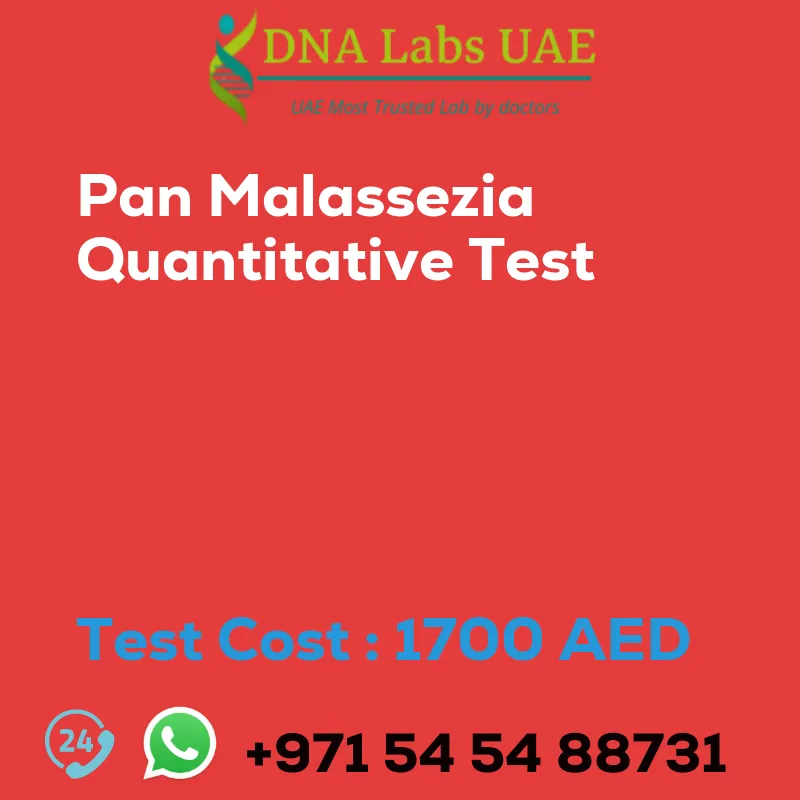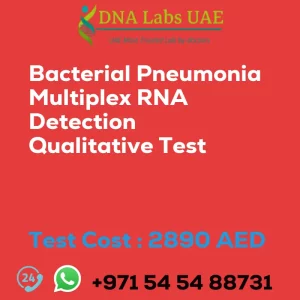Pan Malassezia Quantitative Test
Welcome to DNA Labs UAE, your trusted genetic lab for all your testing needs. Today, we will be discussing the Pan Malassezia Quantitative Test and its importance in diagnosing and monitoring Malassezia-related skin conditions.
Test Details
The Pan Malassezia Quantitative Test is a diagnostic test used to measure the amount of Malassezia yeast on the skin. Excessive growth of this yeast can lead to various skin conditions such as dandruff, seborrheic dermatitis, and fungal infections.
The test involves taking a sample of the affected skin or scalp and culturing it in a laboratory. The sample is then analyzed using Real Time RT-PCR to determine the number of Malassezia yeast colonies present.
This quantitative measurement helps in diagnosing and monitoring the severity of Malassezia-related skin conditions. It is particularly useful for individuals who have not responded well to standard treatments or for those with recurring or chronic conditions.
Test Components
The Pan Malassezia Quantitative Test requires fresh tissue biopsy specimens, skin biopsy specimens from patients with disseminated nodular skin lesions, tissue specimens from various body sites (head, skin and soft tissue, eye, bone, lung, cardiac valve, and bone marrow), peripheral blood specimens, and respiratory secretions.
Price and Report Delivery
The cost of the Pan Malassezia Quantitative Test is AED 1700.0. The report will be delivered via email within 4 working days or on the phone within 36 hours.
Pre Test Information
Prior to the test, patients are required to sign a Consent document and bring any clinical history of the patient for the Pan Malassezia Quantitative Test.
Method and Test Type
The Pan Malassezia Quantitative Test is performed using Real Time RT-PCR, a method that allows for accurate and efficient detection of viral components.
The test falls under the category of Viral tests and is conducted by our experienced team of physicians in the Genetics department.
Importance of the Pan Malassezia Quantitative Test
The Pan Malassezia Quantitative Test is a specialized test that is typically only performed by dermatologists or specialized laboratories. It is not a routine test and may not be necessary for all individuals with skin conditions.
However, for individuals who have not responded well to standard treatments or for those with recurring or chronic Malassezia-related skin conditions, this test can provide valuable insights. The results of the test can help guide treatment decisions, such as the use of antifungal medications or topical treatments specifically targeting Malassezia.
It is important to note that a diagnosis can often be made based on clinical evaluation and response to treatment. The Pan Malassezia Quantitative Test is recommended for cases where a more accurate and detailed assessment is required.
At DNA Labs UAE, we strive to provide accurate and reliable testing services to our patients. If you suspect a Malassezia-related skin condition and would like to explore the Pan Malassezia Quantitative Test, please consult with your dermatologist or contact us directly for more information.
| Test Name | Pan Malassezia Quantitatve Test |
|---|---|
| Components | |
| Price | 1700.0 AED |
| Sample Condition | Fresh tissue biopsy specimens, skin biopsy specimen from a patient with disseminated nodular skin lesions, tissue specimens from a variety of body sites (Head, skin and soft tissue, eye, bone, lung, cardiac valve, and bone marrow), peripheral blood specimens, respiratory secretions. |
| Report Delivery | 4th Working Day Email : 48 hours.On phone : 36 hours |
| Method | Real Time RT- PCR |
| Test type | Viral |
| Doctor | Physician |
| Test Department: | Genetics |
| Pre Test Information | Need to sign Consent document and bring any clinical history of patient forPan Malassezia QuantitatveTest |
| Test Details |
The Pan Malassezia Quantitative Test is a diagnostic test used to measure the amount of Malassezia yeast on the skin. Malassezia is a type of yeast that is naturally found on the skin, but excessive growth can lead to skin conditions such as dandruff, seborrheic dermatitis, and fungal infections. The test involves taking a sample of the affected skin or scalp and culturing it in a laboratory. The sample is then analyzed to determine the number of Malassezia yeast colonies present. This quantitative measurement helps in diagnosing and monitoring the severity of Malassezia-related skin conditions. The Pan Malassezia Quantitative Test is particularly useful for individuals who have not responded well to standard treatments or for those with recurring or chronic Malassezia-related skin conditions. The results of the test can help guide treatment decisions, such as the use of antifungal medications or topical treatments specifically targeting Malassezia. It is important to note that the Pan Malassezia Quantitative Test is not a routine test and is typically only performed by dermatologists or specialized laboratories. The test may not be necessary for all individuals with skin conditions, and a diagnosis can often be made based on clinical evaluation and response to treatment. |







